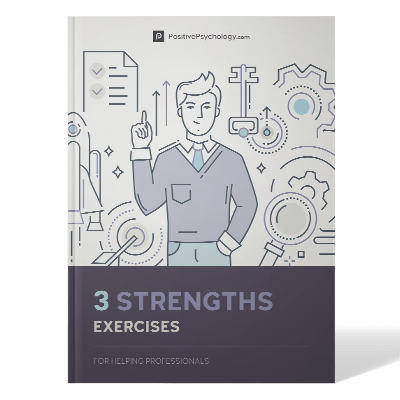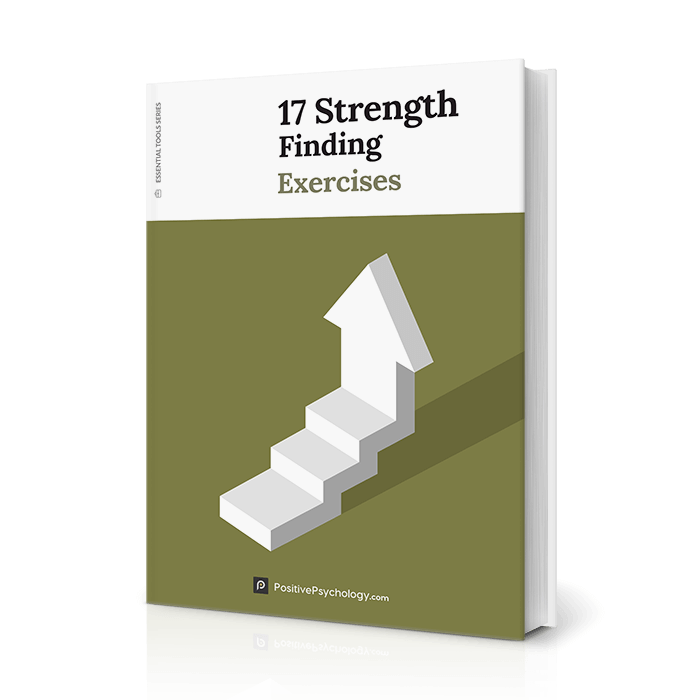9 Strength Finding Tests and Assessments You Can Do Today
 If someone asked you to define your top strengths, how would you respond?
If someone asked you to define your top strengths, how would you respond?
Our strengths reflect inherent potentials that can help us achieve goals across our personal and professional lives.
They define who we are and form a key part of what makes each of us unique.
According to research, there are myriad benefits to understanding one’s inherent strengths, ranging from increased work performance to greater life satisfaction and wellbeing (Douglass & Duffy, 2015; Dubreuil, Forest, & Courcy, 2014; Proctor, Maltby, & Linley, 2011).
Given these diverse benefits, there is clearly value in taking a little time to explore our strengths.
In this post, we’ll breakdown the science behind strength assessment, evidencing its benefits for you and your clients. Following this, we’ll point you toward nine assessments to try out for yourself.
Before you continue, we thought you might like to download our three Strengths Exercises for free. These detailed, science-based exercises will help you or your clients realize your unique potential and create a life that feels energized and authentic.
This Article Contains:
Why Should We Measure Our Strengths?
Strength assessment is a cornerstone of positive psychology. In his writings, Martin Seligman (often thought of as the father of positive psychology) argued that by understanding what people do well, they can be empowered to live a good life across various domains (Peterson & Seligman, 2004).
In particular, much work has been done to apply Seligman’s thinking about strengths to the domains of work and education.
The benefits of strength use at work
Many studies have highlighted the personal and professional benefits of applying our strengths in our jobs.
One review of findings on three prominent workplace strength assessments (VIA, CliftonStrengths, and Strengths Profile) found that applying our strengths in our careers leads to greater job satisfaction, work engagement, wellbeing, and work performance (Miglianico, Dubreuil, Miquelon, Bakker, & Martin‑Krumm, 2020).
Further, regular use of one’s strengths at work has been associated with a reduction of undesirable behaviors, such as interacting rudely with others or showing up late to work (Littman-Ovadia, Lavy, & Boiman-Meshita, 2017).
Interestingly, whether or not we are given opportunities to apply our strengths also affects teams’ performance and motivation.
One study of 72 nursing teams found that teams whose members were more supportive of strength use perceived greater team-based quality of care and were responsible for fewer medication errors (Buljac-Samardžić & van Woerkom, 2018).
Likewise, one study in the context of professional sporting teams found that athletes who felt able to apply their strengths within their team reported greater flourishing and felt more embedded in their team. These effects flowed on to reduce withdrawal behaviors (i.e., a person’s intention to leave the team; Tett & Meyer, 1993).
Overall, these findings point to a range of benefits for both the individual and the firm associated with using one’s strengths in the workplace.
The benefits of strength use in education
With the rise of interest in positive education, there has been an increase in research on the science of strength use in educational settings.
For instance, one study found that the strengths of inquisitiveness and self-control could predict elementary students’ performance on their final exams. Importantly, these pathways were fully mediated by strength use (Tang, Li, Duan, Mu, & Cheng, 2019).
In other words, it was not the mere presence of self-control and inquisitiveness that predicted academic performance but rather the extent to which students actively utilized these strengths throughout the school year that drove this effect.
Looking beyond test scores, strength use is widely believed to aid the development of school-aged students’ social and emotional learning (SEL).
SEL is defined as:
…a process through which youths can acquire the knowledge, attitudes, and skills they need to recognize and manage their emotions, demonstrate caring and concern for others, establish positive relationships, make responsible decisions, and handle challenging situations constructively.
Bates-Krakoff, McGrath, Graves, & Ochs (2017, p. 103)
Several studies have demonstrated the benefits of school-based positive psychology programs that support the development of students’ SEL. One such program, known as Thriving Learning Communities (TLC) has been rolled out across over 90 schools across the United States and five schools in Switzerland.
TLC is a comprehensive character strengths program based on Peterson and Seligman’s (2004) VIA Character Strengths Model. The program has been shown to support a diversity of students, ranging from those who are gifted to those exhibiting behavioral challenges (Bates-Krakoff et al., 2017; Biel, 2020).
Early studies into the benefits of such programs have demonstrated positive effects on a range of SEL outcomes, including conflict resolution, improved classroom behavior, and positive school adjustment (Shoshani & Slone, 2013; Wagner & Ruch, 2015; Weber & Ruch, 2012).
In sum, these findings point to a wide range of benefits associated with strength-use in educational settings.
Hopefully, you now understand the benefits of exploring your strengths and are eager to learn more. To help get you started, we’ll now outline nine fascinating strength-finding tests, several of which you can try for free.
But before we dive in, a quick note.
If you’re a practitioner interested in only the most psychometrically sound tests, we recommend reading about the three most accurate character strength assessments, where we review strengths-based assessments with the most comprehensive support for their reliability and validity.
Now, let’s get started.
Signature Strength Questionnaire (SSQ-72)
The first useful tool for the assessment of character strengths is Rashid and colleagues’ (2013) Signature Strength Questionnaire (SSQ-72).
These scholars designed their assessment to be administered among samples of children as a shortened alternative to the VIA Youth Survey, so it was originally called the Signature Strengths Assessment of Youth (SSAY) Survey.
In line with this focus, the developers of the scale defined ‘strengths’ as they related to the needs of school-aged children, defining them as:
…emotional and behavioral skills, competencies, and characteristics that foster a sense of personal accomplishment, contribute to supportive and satisfying relationships with family members, peers, and adults, enhance one’s ability to cope with challenges and stress, and promote one’s personal, social, and academic development.
Rashid et al. (2013, p. 82)
Today, the scale consists of 72 items assessing the same 24 character strengths as those in the VIA survey, and it is now widely administered among samples of adults.
Some sample items from the scale are as follows:
- I can recall at least three recent occasions when I did what I promised to do.
- I have recently created something such as art, writing, designing.
- I spend substantial time discovering things that I did not know before.
- I recently took responsibility for a thing I did wrong.
- I can recall situations where I have forgiven someone and gave the person a second chance.
All items are presented on 7-point scales, where 1 equals ‘very untrue of me,’ and 7 equals ‘very true of me.’
You can complete the full SSQ-72 assessment for free via the University of Toronto’s Strengths-Based Resilience website.
Wingfinder by Red Bull
The next test we’ll consider is the Red Bull Wingfinder. This tool is a free strength assessment that helps you identify the things you are naturally talented at. It also provides a range of tools and coaching materials to help you develop your strengths.
This test takes approximately 35 minutes to complete, contains around 280 questions, and instantly returns a 19-page feedback report upon completion.
Wingfinder offers a playful, light-hearted approach to exploring four influential factors for determining employability and career success:
- Connections,
- Drive,
- Thinking style, and;
- Creativity.
The test itself is challenging, timed, and highly interactive. It requires quick-thinking and creativity as it tests your abilities using real-life problems and scenarios faced by leaders.
Further, the feedback provided at the end of the assessment will compare your results to those of high-profile athletes, making the tool particularly engaging for young people or those in the early stages of their careers.
You can complete the full Wingfinder assessment for free via Red Bull’s Wingfinder website.
What is gallup strengthsfinder? / What is cliftonstrengths?
The Strength Deployment Inventory
The Strength Deployment Inventory (SDI 2.0) is a popular self-improvement tool, widely used in individual counseling, life coaching, and professional development programs.
The overall aim of the SDI is to improve working relationships by exploring past interactions, choices in the present moment, and future expectations involving interactions with others.
Originally conceptualized by famous American psychologist Elias Hull Porter (1973), the SDI 2.0 provides four views of an individual, thereby going beyond a single assessment of strengths:
- Motivational Value Systems: a snapshot of our personality when things are going well, exploring the underlying causes of our behavior.
- Conflict Sequences: a snapshot of our personality in the heat of conflict, revealing how reactions to stress and adversities differ from person to person.
- A Strengths Portrait: a work-based strength assessment.
- An Overdone Strengths Portrait: a ranking of non-productive work-related strengths.
The assessment contains over 100 questions and provides a ranked breakdown of 28 strengths (and overdone strengths) upon completion of the test. The test also assigns participants to three of seven Motivational Value Systems types and one of 13 Conflict Sequence types.
The feedback provided by the test can then be used by coaches or consultants to facilitate discussion about how to communicate more effectively in organizations.
If you are interested, you can learn more about the SDI 2.0 at the Core Strengths website.
6 Quick Character Strength Worksheets and Tests
For a quick look into your personal and professional strengths (and weaknesses), take a look at some of these short tests and worksheets.
1. Personal SWOT analysis
SWOT is an acronym for strengths, weaknesses, opportunities, and threats.
Strengths and weaknesses center around internal factors, such as pre-existing competencies or skills we do not yet possess. In contrast, opportunities and threats regard factors in our environments that may facilitate our ability to put our strengths to use or threaten to expose our weaknesses.
While SWOT analyzes have traditionally been used in business settings to assess the capabilities of entire firms (Gürel & Tat, 2017), they are now commonly used to assess our capacities as individuals.
To get a sense of how to conduct a Personal SWOT Analysis, take a look at some of these example questions to prompt your thinking about each letter in the SWOT acronym:
| Strengths |
|---|
| – What do you have that others don’t? – What do you do better than others? – How do others describe your strengths? – What values are unique to you? |
| Weaknesses |
| – What are the tasks that you avoid because you don’t think you can do them? – What do you think you are not good at? – How do others describe your weaknesses? – What are the personality traits that hold you back? – What do you think are your negative/bad habits? |
| Opportunities |
| – Do you consider yourself to be part of a growing industry? – If so, how can you use your resources to take advantage of this growth? – Is your company failing to do something? – Is there something that your clients and customers complain about? |
| Threats |
| – What are the roadblocks in your professional life? – Are you a part of an unhealthy competitive environment? – Is changing technology a threat to your current position? – Do you feel threatened by any of your character weaknesses? |
To complete a SWOT analysis yourself, you can access the Personal SWOT Analysis Worksheet for free from the MindTools website.
2. Leadership Legacy Assessment
The Leadership Legacy Assessment was designed by Robert Galford and Regina Maruca to help leaders discover their impact on the people around them and leave a more positive professional legacy.
The test provides respondents with scores out of 25 on six leadership styles:
- Ambassadors — skilled at instinctively handling a variety of situations, diffusing conflict, and persuading others through good relations.
- Advocates — natural spokespeople who champion ideas and persuade others with logic.
- People Movers — strong motivators who set people on new paths and nurture others’ potential.
- Truth-Seekers — skilled at remaining level-headed and process-oriented, with unquestioned competence in their field.
- Creative Builders — energized by new ideas and dedicated to implementing them successfully.
- Experienced Guides — skilled at putting themselves in others’ shoes and helping them through their problems by drawing on past experiences.
The test comprises 30 questions in total. All items are presented on 5-point scales, where 1 equals ‘that would almost never be me,’ and 5 equals ‘I’m nearly always like that.’
To learn more, take a look at the creators’ book, Your Leadership Legacy, and complete the test for yourself at the Galford and Maruca’s website.
3. Situational Strengths Test (SST)
The Situational Strengths Test is designed to assess the presence of skills and strengths that employers are looking for in the early stages of the recruitment process.
In the test, candidates are presented with short scenarios detailing situations that may arise in one’s work. They will then be presented with a question about how they would respond behaviorally in that scenario and are prompted to choose a behavior out of a series of options.
If you are interested in trying a free Situational Strengths Test for yourself, you can do so at the Practice Aptitude Tests website.
4. Strength Regulation Worksheet
Not only is it important to be aware of our strengths, but it is also critical to remain mindful of how we apply them in our day-to-day life. If we don’t, we may inadvertently under- or over-utilize our strengths (Niemiec, 2014).
The Strength Regulation Worksheet is a useful tcool to help you or your clients to identify times when they may have under- or over-played their strengths inappropriately in a given situation. The client can then plan to use that strength at a more optimal level in the future.
If you are interested, you can access the Strength Regulation Worksheet from the Positive Psychology Toolkit©.
5. My Strengths and Qualities Worksheet
Understanding our strengths is essential for building strong self-esteem and a good overall self-image.
The My Strengths and Qualities Worksheet can serve as a useful first step toward helping your clients identify their strengths by thinking carefully about compliments they’ve received, times they’ve felt happy, challenges they’ve overcome, and more.
To complete the assessment for yourself, you can access the worksheet for free from the MindTools website.
6. The HIGH5 Strengths Test
The HIGH 5 Test is a free online strength assessment rooted in the principles of positive psychology and dedicated to helping people better understand themselves and appreciate themselves more.
The test assesses 20 applicable strengths across four different domains. Examples of strength profiles identified by the test include Problem Solver, Empathizer, and Winner, to name a few.
The test takes approximately 15 minutes to complete and comprises 100 questions. All responses are provided using a slider, with anchors ranging from ‘strongly disagree’ to ‘strongly agree.’ Upon completion of the test, you will receive a brief summary of your top-five strengths, with the option to receive a detailed report for a fee.
You can discover your top five strengths for yourself by completing the test at the HIGH5 website.
A Take-Home Message
Most psychologists would agree that understanding your strengths is critical for self-growth and ongoing improvement. Further, by discovering your strengths, you can leverage them in both your personal and professional life to maximum effect.
Perhaps most importantly, understanding your strengths can contribute to forming a healthy sense of self, enabling you to operate in the world feeling effective, grounded, and self-confident. So be sure to take some time to complete a few of these tests and discover what you do best today.
We hope you enjoyed reading this article. Don’t forget to download our three Strengths Exercises for free
- Bates-Krakoff, J., McGrath, R. E., Graves, K., & Ochs, L. (2017). Beyond a deficit model of strengths training in schools: Teaching targeted strength use to gifted students. Gifted Education International, 33(2), 102-117.
- Biel, A. P. (2020). Teaching to strengths: Evaluation of a character strength curriculum and disciplinary outcomes (Doctoral dissertation, Xavier University, Cincinnati, OH). Retrieved from http://rave.ohiolink.edu/etdc/view?acc_num=xavier1564788317136618
- Buljac-Samardžić, M., & van Woerkom, M. (2018). Improving quality and safety of care in nursing homes by team support for strengths use: A survey study. Plos one, 13(7).
- Douglass, R. P., & Duffy, R. D. (2015). Strengths use and life satisfaction: A moderated mediation approach. Journal of Happiness Studies, 16(3), 619-632.
- Dubreuil, P., Forest, J., & Courcy, F. (2014). From strengths use to work performance: The role of harmonious passion, subjective vitality, and concentration. The Journal of Positive Psychology, 9(4), 335-349.
- Gürel, E., & Tat, M. (2017). SWOT analysis: a theoretical review. Journal of International Social Research, 10(51), 994-1006.
- Littman-Ovadia, H., Lavy, S., & Boiman-Meshita, M. (2017). When theory and research collide: Examining correlates of signature strengths use at work. Journal of Happiness Studies, 18(2), 527-548.
- Miglianico, M., Dubreuil, P., Miquelon, P., Bakker, A. B., & Martin-Krumm, C. (2020). Strength use in the workplace: A literature review. Journal of Happiness Studies, 21(2), 737-764.
- Niemiec, R. M. (2014). Mindfulness and character strengths: A practical guide to flourishing. Boston, MA: Hogrefe.
- Peterson, C., & Seligman, M. E. (2004). Character strengths and virtues: A handbook and classification (Vol. 1). New York, NY: Oxford University Press.
- Porter, E. H. (1973). Strength Deployment Inventory: First manual of administration and interpretation. Pacific Palisades, CA: Personal Strengths Assessment Service.
- Proctor, C., Maltby, J., & Linley, P. A. (2011). Strengths use as a predictor of well-being and health-related quality of life. Journal of Happiness Studies, 12(1), 153-169.
- Rashid, T., Anjum, A., Lennox, C., Quinlan, D., Niemiec, R. M., Mayerson, D., & Kazemi, F. (2013). Assessment of character strengths in children and adolescents. In C. Proctor & P. A. Linley (Eds.), Research, applications, and interventions for children and adolescents: A positive psychology perspective (pp. 81-115). Dordrecht: Springer.
- Shoshani, A., & Slone, M. (2013). Middle school transition from the strengths perspective: Young adolescents’ character strengths, subjective well-being, and school adjustment. Journal of Happiness Studies, 14(4), 1163-1181.
- Tang, X., Li, Y., Duan, W., Mu, W., & Cheng, X. (2019). Character strengths lead to satisfactory educational outcomes through strength use: A longitudinal analysis. Frontiers in psychology, 10.
- Tett, R. P., & Meyer, J. P. (1993). Job satisfaction, organizational commitment, turnover intention, and turnover: path analyses based on meta‐analytic findings. Personnel Psychology, 46(2), 259-293.
- Wagner, L., & Ruch, W. (2015). Good character at school: Positive classroom behavior mediates the link between character strengths and school achievement. Frontiers in Psychology, 6.
- Weber, M., & Ruch, W. (2012). The role of a good character in 12-year-old school children: Do character strengths matter in the classroom? Child Indicators Research, 5(2), 317-334.
Let us know your thoughts
Read other articles by their category
- Body & Brain (49)
- Coaching & Application (57)
- Compassion (26)
- Counseling (51)
- Emotional Intelligence (24)
- Gratitude (18)
- Grief & Bereavement (21)
- Happiness & SWB (40)
- Meaning & Values (26)
- Meditation (20)
- Mindfulness (45)
- Motivation & Goals (45)
- Optimism & Mindset (34)
- Positive CBT (29)
- Positive Communication (20)
- Positive Education (47)
- Positive Emotions (32)
- Positive Leadership (18)
- Positive Parenting (4)
- Positive Psychology (33)
- Positive Workplace (37)
- Productivity (17)
- Relationships (46)
- Resilience & Coping (36)
- Self Awareness (21)
- Self Esteem (38)
- Strengths & Virtues (32)
- Stress & Burnout Prevention (34)
- Theory & Books (46)
- Therapy Exercises (37)
- Types of Therapy (64)





What our readers think
Hi! One correction I wanted to point out. The father of positive psychology is Martin Seligman. The man you listed, Peter Seligman, is a non-profit founder.
Hi Andrew,
Whoops! Thanks for catching this typo for us. We’ve corrected it 🙂
– Nicole | Community Manager
Thank you Nicole for this article, it looks like it was refreshed in 2021. I work to help people activate strengths in work and life. The one thing I would add or reframe is the use of a personal SWOT, coming from a positive psychology approach includes an appreciative and generative mindset. SOAR is a more affirmative way to reframe weaknesses and threats into opportunities. Check out SOAR, creating strategy that inspires innovation and engagement by Jackie Stavros, and Gina Hinrichs. I work with a tool called Strengthscope that identifies people’s natural, intrinsic motivators and strengths and is not a free tool and has to be accessed through a certified facilitator. I appreciate your efforts to help people find free resources in this article.